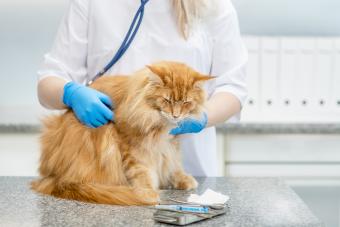
It's not necessarily time to panic if you notice a small amount of blood in your cat's stool. Mild rectal irritation can cause some bleeding, but it's important to understand some of the other, more serious reasons your kitty may have blood in their poop.
Reasons for Blood in Cats' Stools
According to VetInfo.com, bloody stool in cats may indicate some conditions, including:
- Bacterial infections, including Salmonella and E. coli
- Viral infections, including feline panleukopenia
- Parasites, including worms, cryptosporidia, and coccidia
- Food intolerance or allergy
- Polyps (noncancerous)
- Cancer of the stomach or intestines
- Ingestion of a toxin like rodent poison or ibuprofen
- Damage to the anus or lower bowel
- Low platelet count or blood clot disorder
- Obstructions
- Constipation
- Inflammatory bowel disease (IBD)
- Anal gland infection or rupture
- Stomach ulcers
- Stress or anxiety
When to See Your Vet About Your Cat or Kitten Pooping Blood
Call your vet as soon as possible if you notice any of the following symptoms:
- Bright red blood (more than a single time or more than a speck)
- Black, tarry stools or feces that look like coffee grounds
- Problems defecating, such as significant straining when trying to defecate
- Significant increase in number of times cat defecates each day
- Urgency when defecating or not making it to the litterbox
Additional Symptoms to Watch for With Bloody Stool
Sometimes bloody stools are just one sign something is wrong. If your pet has any accompanying symptoms, such as those listed below, that is even more reason to call your vet.
- Vomiting
- Diarrhea
- Loss of appetite
- Weight loss
- Pale mucous membranes
- Extreme lethargy
- Excessive licking of the rear or scooting
Diagnosing the Cause of Bloody Stool in Cats
Determining what's causing the bleeding can be a complicated process. It includes examining the cat and a sample of its feces, running tests, and gathering information to get a better idea of what's been going on.
Tests Commonly Used for Diagnosing Blood in Poop
There are several tests your veterinarian may decide to run:
- Examination of the rectal area
- Fecal material analysis
- Complete blood count (CBC)
- Chemistry panel to evaluate organ function and electrolyte levels
- Urinalysis
- Abdominal x-rays
- Ultrasound of the abdominal area
- Colonoscopy or endoscopy
Questions Your Vet May Ask
Your vet will also need to gather as much information from you as possible to reach an accurate diagnosis. Typical questions might include:
- Could your cat have eaten spoiled food or ingested nonfood items, such as bones or toxins?
- Has there been a recent change in your pet's diet?
- Has your cat eaten any people food? If so, what?
- Has your cat experienced any trauma to the anal area, such as a bite from another animal or a blunt force injury?
- Have you noticed the cat rubbing its rear on the carpets? This could indicate anal sac problems.
- When was the last time your cat was dewormed?
- Is your kitten up to date on vaccines? Have they been exposed to any unwell cats?
Hematochezia or Melena?
The state of the blood in a cat's stools can also give the vet a better idea of where the bleeding is coming from.
- Hematochezia is the presence of a bright red blood in the stool. Bright red blood is usually an indication of bleeding in the lower intestines or rectum, although the actual bleeding can be caused by a wide variety of problems, such as parasites in younger cats and cancer in older cats. However, this is not always the case, and only your veterinarian can make a valid diagnosis by running tests, such as the ones listed above.
- Melena is a dark, tar-like feces. Some people describe this type of stool as looking like black coffee grounds. Melena is a result of passing older or partially digested blood, which indicates a problem higher in the intestinal tract, like the esophagus or stomach.
Possible Treatments for Bloody Stool in Kittens and Cats

Depending upon the results of the tests and the suspected cause of the symptoms, your vet may recommend some of the following treatments to help relieve your feline of their bloody stools:
- Prescription foods or a bland diet to help ease the strain on the intestines
- Fluid therapy to treat dehydration and help fight off infection
- Anti-nausea and pain medicine
- Medication to treat internal parasites
- Antibiotics such as Flagyl, if your cat has a bacterial infection
- Oral gastrointestinal protectant medications
Take a Stool Sample to Your Vet
Whenever you notice your cat has bloody stools, be sure to collect a sample of the fecal matter for examination. Place the stool sample into a plastic baggie and take it to your vet as soon as you can. This is probably the first and easiest test your veterinarian can run, and it will tell you if there is evidence of most common parasites or bacterial overgrowth. Most conditions are easier to treat at the onset, so seek veterinary care for your cat any time significant health changes occur.







